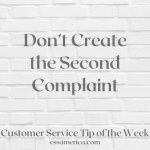
Getting philosophical for the next 300 words.
The angry customer. The pushy or obnoxious co-workers. The demanding manager. The products that don’t always work. The stress on the faces and in the voices of customers and the employees serving them.
There are many dark moments that you may have to deal with during the course of your week at work. These are the dark encounters of our work day, those that can bring down morale, reduce the joy, and dampen employee enthusiasm.
But there is a light. There is a source of positivity, laughter, vision, and empathy. And that light is you.
I’ve been in some focus groups of employees discussing low morale. It seems like half the staff have the mindset of “once leaders change, then I’ll change.” While the other half seem to say “I’m not going to wait for others to behave professionally or positively before I act that way as well. They don’t control my behaviors.”
There’s an obvious difference in the two reactions. The first is passivity in the darkness. The second is taking ownership.
When we have a light – a positive nature, kindness, professionalism, respect, empathy and encouragement – we can be like the light in a room. Have you ever been in a room with a couple large mirrors? Those mirrors reflect that one light, helping the entire room to brighten more than it would otherwise.
The point is that dark situations at work should be opportunities for us – opportunities to bring in light. Opportunities to have your light be reflected in the attitudes and actions of others.
Be the Light that Others Reflect.
Signup for FREE Tips! Contact Us More Resources for You Visit Our Home Page























